eBusiness Challenges and Opportunities: eBay Australia
VerifiedAdded on 2023/06/03
|14
|4060
|341
Project
AI Summary
This research proposal investigates the challenges and opportunities of eBusiness, specifically focusing on eBay Australia. The study aims to analyze the role of eBusiness in the contemporary business environment, evaluate the challenges faced by eBay, and identify strategies to leverage available opportunities. The proposal outlines the project objectives, scope, and a comprehensive literature review covering key aspects of eBusiness. The research design employs a qualitative approach, including data collection through questionnaires and an interpretivism research philosophy. The study also addresses research limitations and provides a detailed time schedule for completion. The proposal seeks to understand the dynamics of the eBusiness market, providing valuable insights for eBay and other businesses operating in this sector, offering strategies to navigate the challenges and capitalize on the opportunities in the eBusiness landscape.
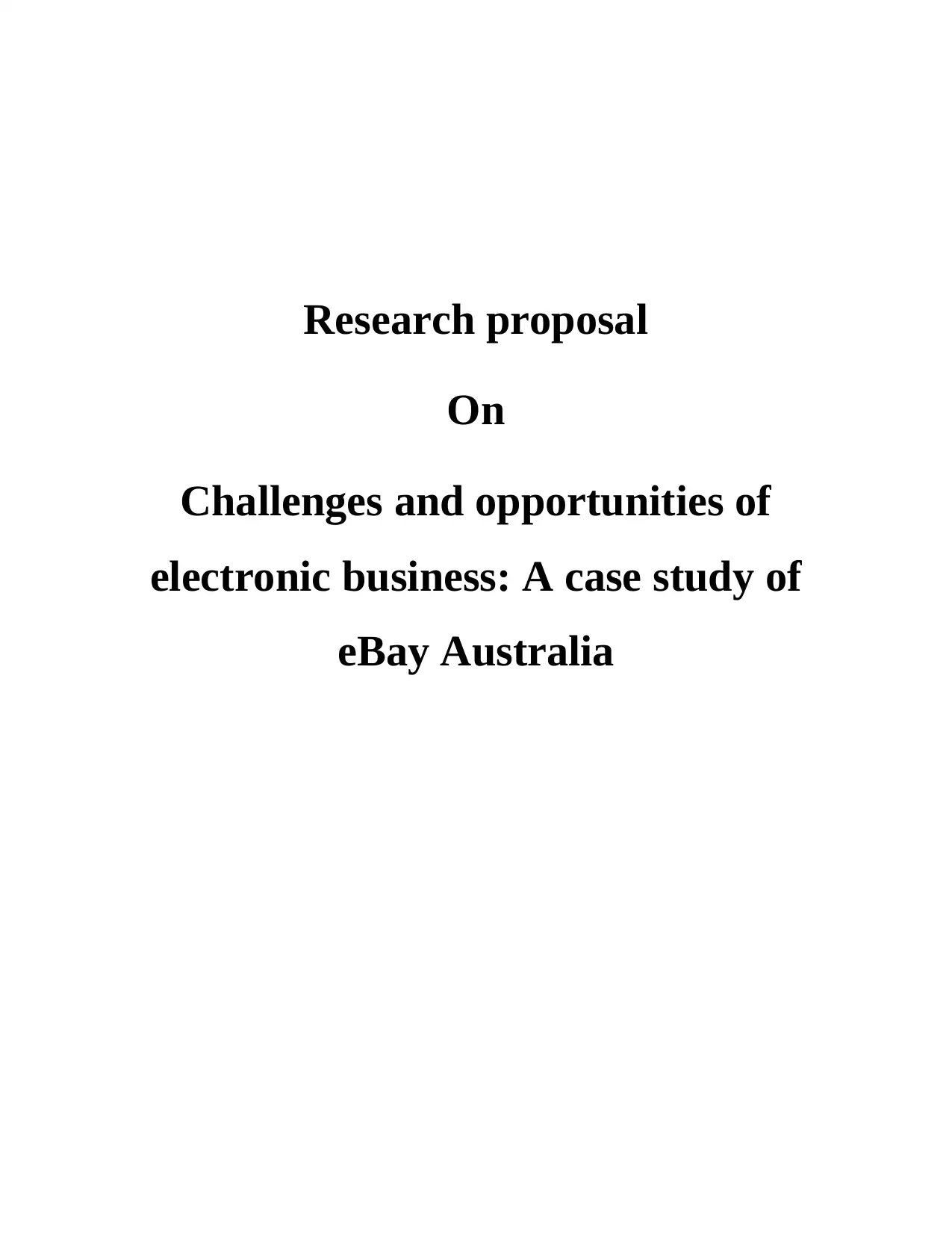
Research proposal
On
Challenges and opportunities of
electronic business: A case study of
eBay Australia
On
Challenges and opportunities of
electronic business: A case study of
eBay Australia
Paraphrase This Document
Need a fresh take? Get an instant paraphrase of this document with our AI Paraphraser
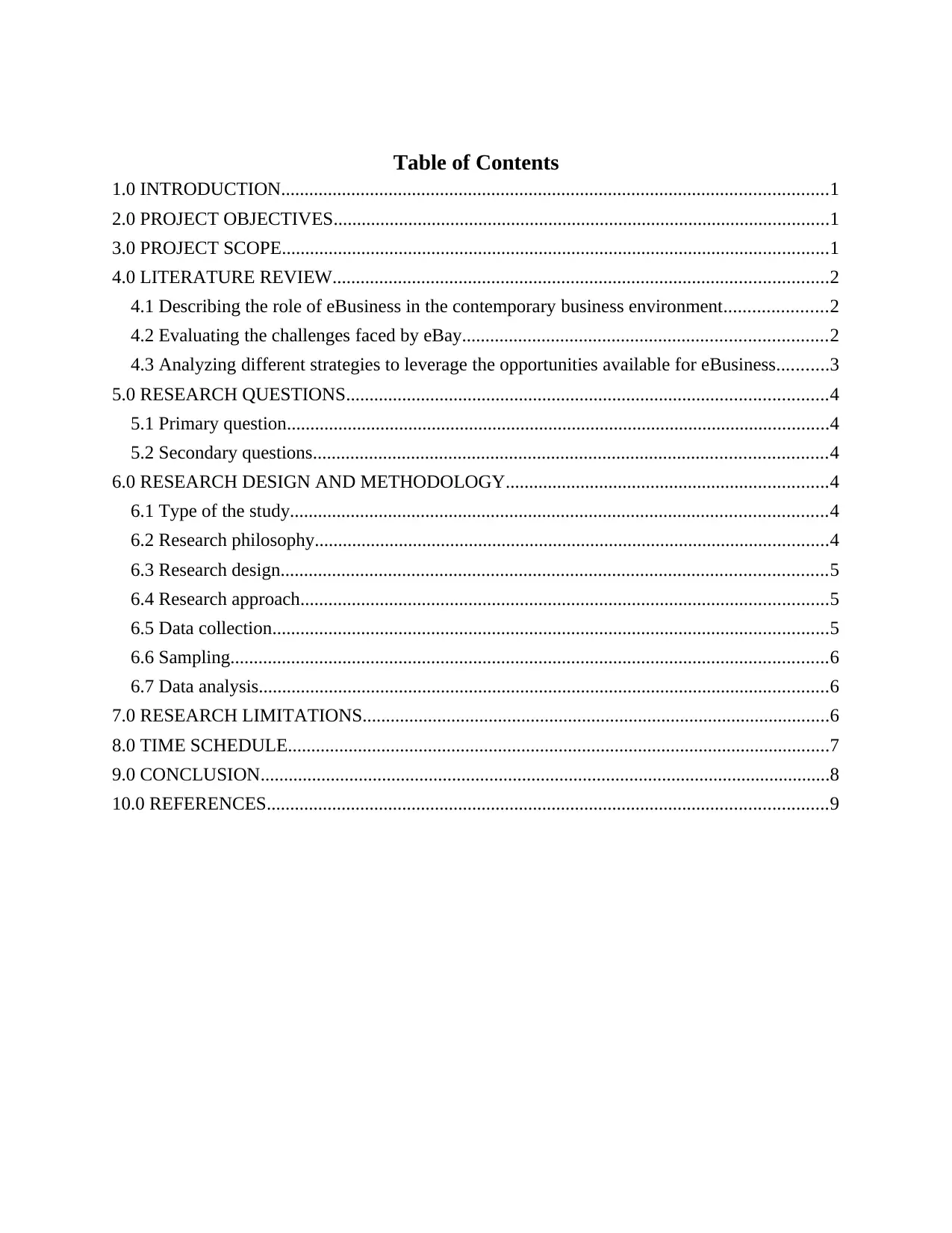
Table of Contents
1.0 INTRODUCTION.....................................................................................................................1
2.0 PROJECT OBJECTIVES..........................................................................................................1
3.0 PROJECT SCOPE.....................................................................................................................1
4.0 LITERATURE REVIEW..........................................................................................................2
4.1 Describing the role of eBusiness in the contemporary business environment......................2
4.2 Evaluating the challenges faced by eBay..............................................................................2
4.3 Analyzing different strategies to leverage the opportunities available for eBusiness...........3
5.0 RESEARCH QUESTIONS.......................................................................................................4
5.1 Primary question....................................................................................................................4
5.2 Secondary questions..............................................................................................................4
6.0 RESEARCH DESIGN AND METHODOLOGY.....................................................................4
6.1 Type of the study...................................................................................................................4
6.2 Research philosophy..............................................................................................................4
6.3 Research design.....................................................................................................................5
6.4 Research approach.................................................................................................................5
6.5 Data collection.......................................................................................................................5
6.6 Sampling................................................................................................................................6
6.7 Data analysis..........................................................................................................................6
7.0 RESEARCH LIMITATIONS....................................................................................................6
8.0 TIME SCHEDULE....................................................................................................................7
9.0 CONCLUSION..........................................................................................................................8
10.0 REFERENCES........................................................................................................................9
1.0 INTRODUCTION.....................................................................................................................1
2.0 PROJECT OBJECTIVES..........................................................................................................1
3.0 PROJECT SCOPE.....................................................................................................................1
4.0 LITERATURE REVIEW..........................................................................................................2
4.1 Describing the role of eBusiness in the contemporary business environment......................2
4.2 Evaluating the challenges faced by eBay..............................................................................2
4.3 Analyzing different strategies to leverage the opportunities available for eBusiness...........3
5.0 RESEARCH QUESTIONS.......................................................................................................4
5.1 Primary question....................................................................................................................4
5.2 Secondary questions..............................................................................................................4
6.0 RESEARCH DESIGN AND METHODOLOGY.....................................................................4
6.1 Type of the study...................................................................................................................4
6.2 Research philosophy..............................................................................................................4
6.3 Research design.....................................................................................................................5
6.4 Research approach.................................................................................................................5
6.5 Data collection.......................................................................................................................5
6.6 Sampling................................................................................................................................6
6.7 Data analysis..........................................................................................................................6
7.0 RESEARCH LIMITATIONS....................................................................................................6
8.0 TIME SCHEDULE....................................................................................................................7
9.0 CONCLUSION..........................................................................................................................8
10.0 REFERENCES........................................................................................................................9
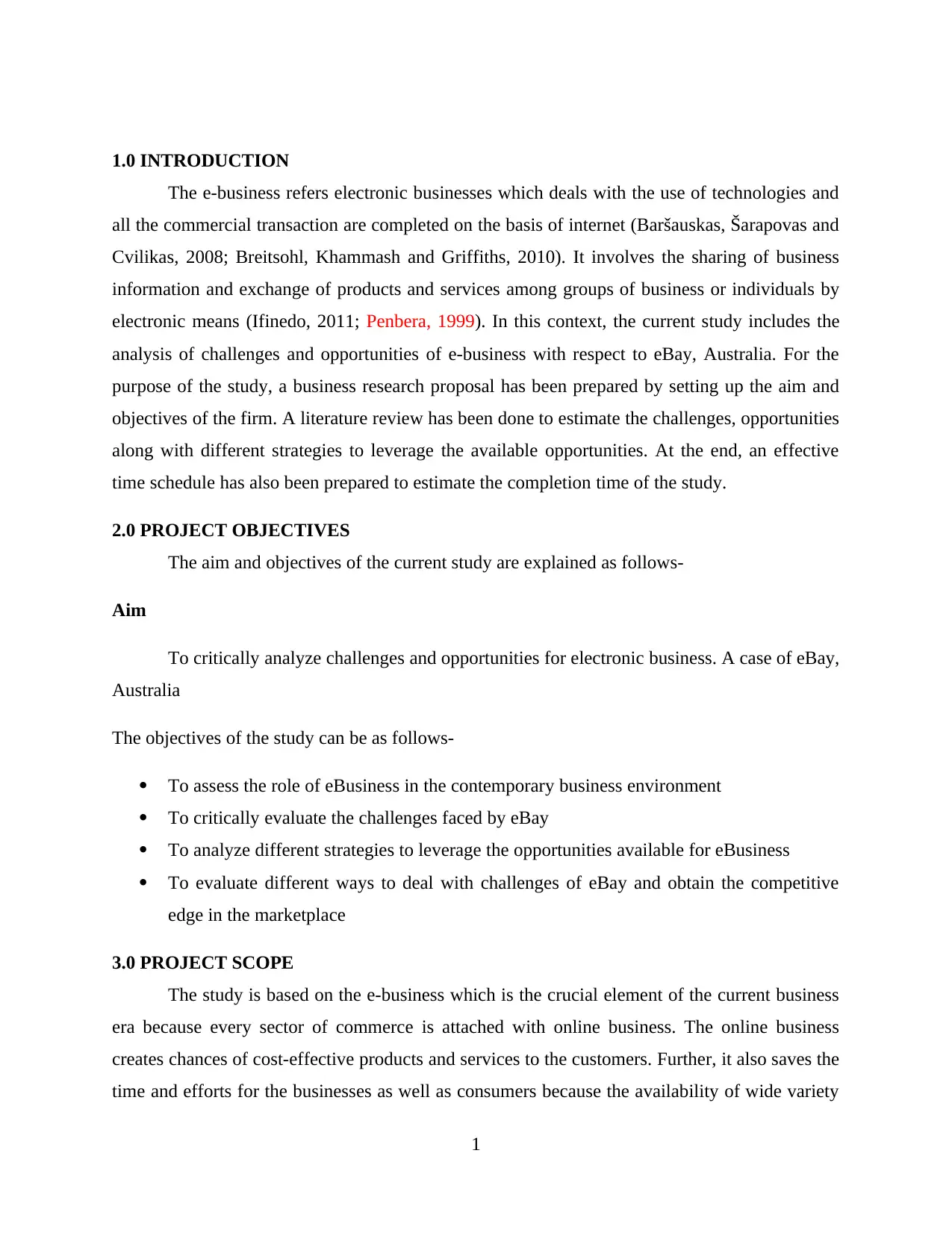
1.0 INTRODUCTION
The e-business refers electronic businesses which deals with the use of technologies and
all the commercial transaction are completed on the basis of internet (Baršauskas, Šarapovas and
Cvilikas, 2008; Breitsohl, Khammash and Griffiths, 2010). It involves the sharing of business
information and exchange of products and services among groups of business or individuals by
electronic means (Ifinedo, 2011; Penbera, 1999). In this context, the current study includes the
analysis of challenges and opportunities of e-business with respect to eBay, Australia. For the
purpose of the study, a business research proposal has been prepared by setting up the aim and
objectives of the firm. A literature review has been done to estimate the challenges, opportunities
along with different strategies to leverage the available opportunities. At the end, an effective
time schedule has also been prepared to estimate the completion time of the study.
2.0 PROJECT OBJECTIVES
The aim and objectives of the current study are explained as follows-
Aim
To critically analyze challenges and opportunities for electronic business. A case of eBay,
Australia
The objectives of the study can be as follows-
To assess the role of eBusiness in the contemporary business environment
To critically evaluate the challenges faced by eBay
To analyze different strategies to leverage the opportunities available for eBusiness
To evaluate different ways to deal with challenges of eBay and obtain the competitive
edge in the marketplace
3.0 PROJECT SCOPE
The study is based on the e-business which is the crucial element of the current business
era because every sector of commerce is attached with online business. The online business
creates chances of cost-effective products and services to the customers. Further, it also saves the
time and efforts for the businesses as well as consumers because the availability of wide variety
1
The e-business refers electronic businesses which deals with the use of technologies and
all the commercial transaction are completed on the basis of internet (Baršauskas, Šarapovas and
Cvilikas, 2008; Breitsohl, Khammash and Griffiths, 2010). It involves the sharing of business
information and exchange of products and services among groups of business or individuals by
electronic means (Ifinedo, 2011; Penbera, 1999). In this context, the current study includes the
analysis of challenges and opportunities of e-business with respect to eBay, Australia. For the
purpose of the study, a business research proposal has been prepared by setting up the aim and
objectives of the firm. A literature review has been done to estimate the challenges, opportunities
along with different strategies to leverage the available opportunities. At the end, an effective
time schedule has also been prepared to estimate the completion time of the study.
2.0 PROJECT OBJECTIVES
The aim and objectives of the current study are explained as follows-
Aim
To critically analyze challenges and opportunities for electronic business. A case of eBay,
Australia
The objectives of the study can be as follows-
To assess the role of eBusiness in the contemporary business environment
To critically evaluate the challenges faced by eBay
To analyze different strategies to leverage the opportunities available for eBusiness
To evaluate different ways to deal with challenges of eBay and obtain the competitive
edge in the marketplace
3.0 PROJECT SCOPE
The study is based on the e-business which is the crucial element of the current business
era because every sector of commerce is attached with online business. The online business
creates chances of cost-effective products and services to the customers. Further, it also saves the
time and efforts for the businesses as well as consumers because the availability of wide variety
1
⊘ This is a preview!⊘
Do you want full access?
Subscribe today to unlock all pages.

Trusted by 1+ million students worldwide
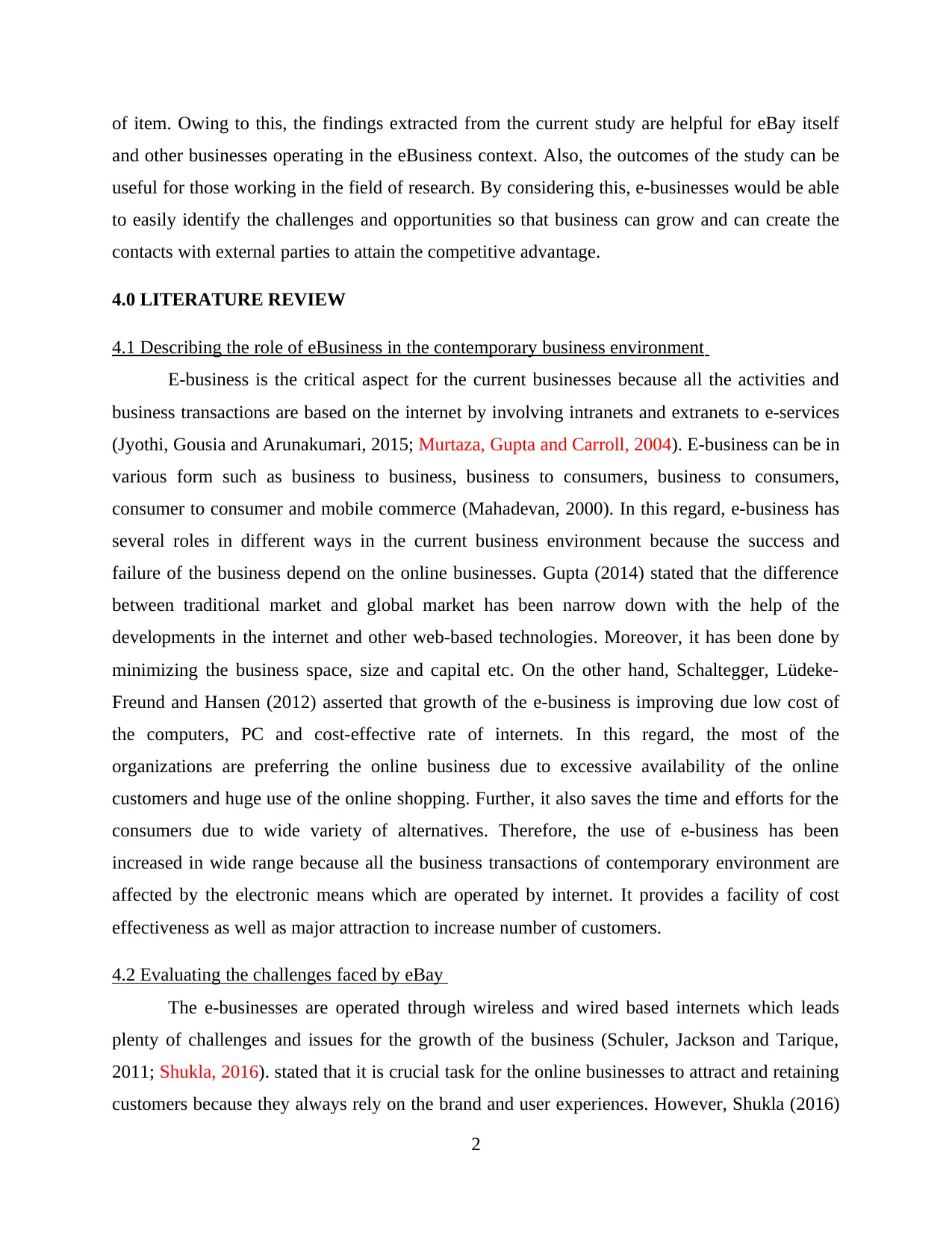
of item. Owing to this, the findings extracted from the current study are helpful for eBay itself
and other businesses operating in the eBusiness context. Also, the outcomes of the study can be
useful for those working in the field of research. By considering this, e-businesses would be able
to easily identify the challenges and opportunities so that business can grow and can create the
contacts with external parties to attain the competitive advantage.
4.0 LITERATURE REVIEW
4.1 Describing the role of eBusiness in the contemporary business environment
E-business is the critical aspect for the current businesses because all the activities and
business transactions are based on the internet by involving intranets and extranets to e-services
(Jyothi, Gousia and Arunakumari, 2015; Murtaza, Gupta and Carroll, 2004). E-business can be in
various form such as business to business, business to consumers, business to consumers,
consumer to consumer and mobile commerce (Mahadevan, 2000). In this regard, e-business has
several roles in different ways in the current business environment because the success and
failure of the business depend on the online businesses. Gupta (2014) stated that the difference
between traditional market and global market has been narrow down with the help of the
developments in the internet and other web-based technologies. Moreover, it has been done by
minimizing the business space, size and capital etc. On the other hand, Schaltegger, Lüdeke-
Freund and Hansen (2012) asserted that growth of the e-business is improving due low cost of
the computers, PC and cost-effective rate of internets. In this regard, the most of the
organizations are preferring the online business due to excessive availability of the online
customers and huge use of the online shopping. Further, it also saves the time and efforts for the
consumers due to wide variety of alternatives. Therefore, the use of e-business has been
increased in wide range because all the business transactions of contemporary environment are
affected by the electronic means which are operated by internet. It provides a facility of cost
effectiveness as well as major attraction to increase number of customers.
4.2 Evaluating the challenges faced by eBay
The e-businesses are operated through wireless and wired based internets which leads
plenty of challenges and issues for the growth of the business (Schuler, Jackson and Tarique,
2011; Shukla, 2016). stated that it is crucial task for the online businesses to attract and retaining
customers because they always rely on the brand and user experiences. However, Shukla (2016)
2
and other businesses operating in the eBusiness context. Also, the outcomes of the study can be
useful for those working in the field of research. By considering this, e-businesses would be able
to easily identify the challenges and opportunities so that business can grow and can create the
contacts with external parties to attain the competitive advantage.
4.0 LITERATURE REVIEW
4.1 Describing the role of eBusiness in the contemporary business environment
E-business is the critical aspect for the current businesses because all the activities and
business transactions are based on the internet by involving intranets and extranets to e-services
(Jyothi, Gousia and Arunakumari, 2015; Murtaza, Gupta and Carroll, 2004). E-business can be in
various form such as business to business, business to consumers, business to consumers,
consumer to consumer and mobile commerce (Mahadevan, 2000). In this regard, e-business has
several roles in different ways in the current business environment because the success and
failure of the business depend on the online businesses. Gupta (2014) stated that the difference
between traditional market and global market has been narrow down with the help of the
developments in the internet and other web-based technologies. Moreover, it has been done by
minimizing the business space, size and capital etc. On the other hand, Schaltegger, Lüdeke-
Freund and Hansen (2012) asserted that growth of the e-business is improving due low cost of
the computers, PC and cost-effective rate of internets. In this regard, the most of the
organizations are preferring the online business due to excessive availability of the online
customers and huge use of the online shopping. Further, it also saves the time and efforts for the
consumers due to wide variety of alternatives. Therefore, the use of e-business has been
increased in wide range because all the business transactions of contemporary environment are
affected by the electronic means which are operated by internet. It provides a facility of cost
effectiveness as well as major attraction to increase number of customers.
4.2 Evaluating the challenges faced by eBay
The e-businesses are operated through wireless and wired based internets which leads
plenty of challenges and issues for the growth of the business (Schuler, Jackson and Tarique,
2011; Shukla, 2016). stated that it is crucial task for the online businesses to attract and retaining
customers because they always rely on the brand and user experiences. However, Shukla (2016)
2
Paraphrase This Document
Need a fresh take? Get an instant paraphrase of this document with our AI Paraphraser
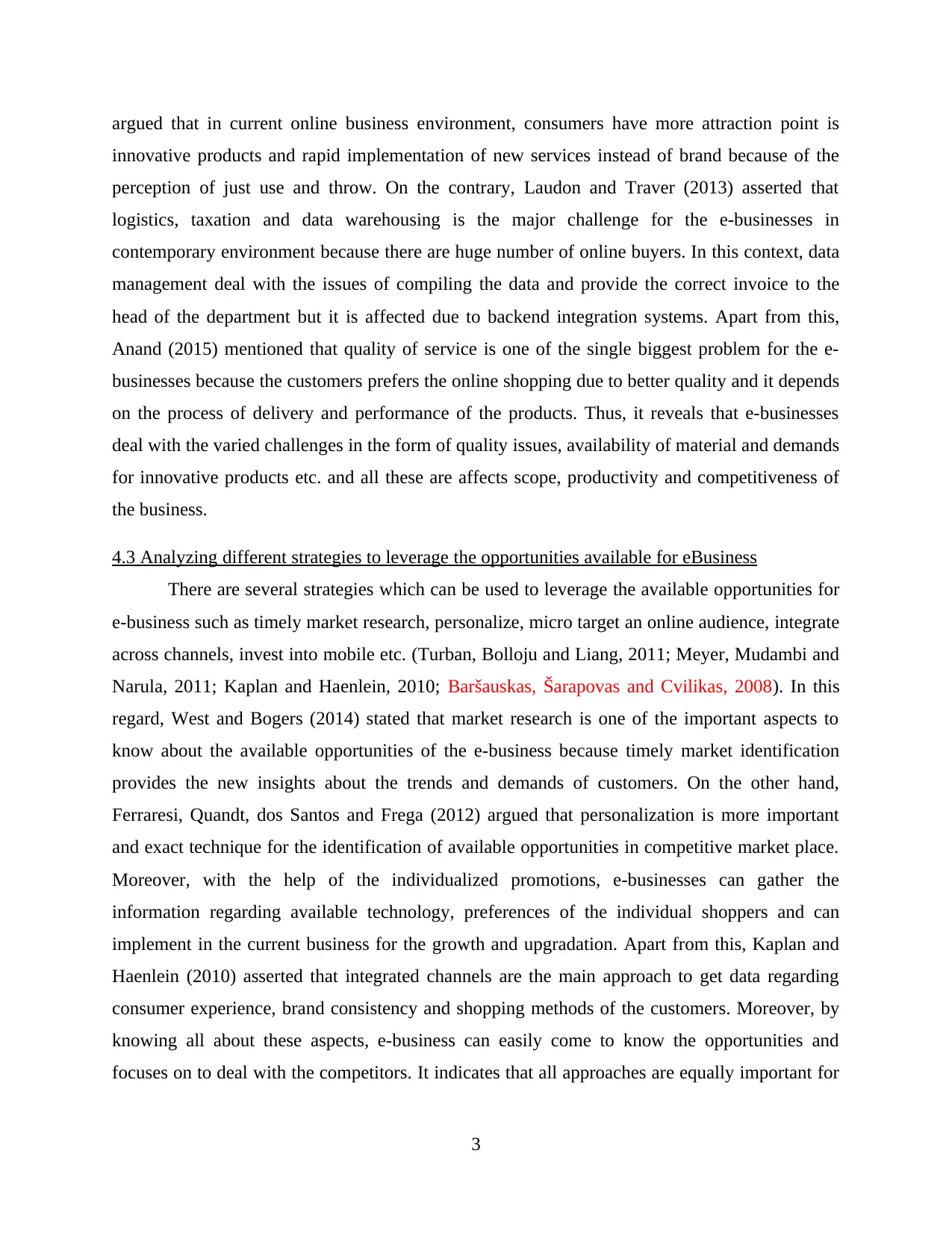
argued that in current online business environment, consumers have more attraction point is
innovative products and rapid implementation of new services instead of brand because of the
perception of just use and throw. On the contrary, Laudon and Traver (2013) asserted that
logistics, taxation and data warehousing is the major challenge for the e-businesses in
contemporary environment because there are huge number of online buyers. In this context, data
management deal with the issues of compiling the data and provide the correct invoice to the
head of the department but it is affected due to backend integration systems. Apart from this,
Anand (2015) mentioned that quality of service is one of the single biggest problem for the e-
businesses because the customers prefers the online shopping due to better quality and it depends
on the process of delivery and performance of the products. Thus, it reveals that e-businesses
deal with the varied challenges in the form of quality issues, availability of material and demands
for innovative products etc. and all these are affects scope, productivity and competitiveness of
the business.
4.3 Analyzing different strategies to leverage the opportunities available for eBusiness
There are several strategies which can be used to leverage the available opportunities for
e-business such as timely market research, personalize, micro target an online audience, integrate
across channels, invest into mobile etc. (Turban, Bolloju and Liang, 2011; Meyer, Mudambi and
Narula, 2011; Kaplan and Haenlein, 2010; Baršauskas, Šarapovas and Cvilikas, 2008). In this
regard, West and Bogers (2014) stated that market research is one of the important aspects to
know about the available opportunities of the e-business because timely market identification
provides the new insights about the trends and demands of customers. On the other hand,
Ferraresi, Quandt, dos Santos and Frega (2012) argued that personalization is more important
and exact technique for the identification of available opportunities in competitive market place.
Moreover, with the help of the individualized promotions, e-businesses can gather the
information regarding available technology, preferences of the individual shoppers and can
implement in the current business for the growth and upgradation. Apart from this, Kaplan and
Haenlein (2010) asserted that integrated channels are the main approach to get data regarding
consumer experience, brand consistency and shopping methods of the customers. Moreover, by
knowing all about these aspects, e-business can easily come to know the opportunities and
focuses on to deal with the competitors. It indicates that all approaches are equally important for
3
innovative products and rapid implementation of new services instead of brand because of the
perception of just use and throw. On the contrary, Laudon and Traver (2013) asserted that
logistics, taxation and data warehousing is the major challenge for the e-businesses in
contemporary environment because there are huge number of online buyers. In this context, data
management deal with the issues of compiling the data and provide the correct invoice to the
head of the department but it is affected due to backend integration systems. Apart from this,
Anand (2015) mentioned that quality of service is one of the single biggest problem for the e-
businesses because the customers prefers the online shopping due to better quality and it depends
on the process of delivery and performance of the products. Thus, it reveals that e-businesses
deal with the varied challenges in the form of quality issues, availability of material and demands
for innovative products etc. and all these are affects scope, productivity and competitiveness of
the business.
4.3 Analyzing different strategies to leverage the opportunities available for eBusiness
There are several strategies which can be used to leverage the available opportunities for
e-business such as timely market research, personalize, micro target an online audience, integrate
across channels, invest into mobile etc. (Turban, Bolloju and Liang, 2011; Meyer, Mudambi and
Narula, 2011; Kaplan and Haenlein, 2010; Baršauskas, Šarapovas and Cvilikas, 2008). In this
regard, West and Bogers (2014) stated that market research is one of the important aspects to
know about the available opportunities of the e-business because timely market identification
provides the new insights about the trends and demands of customers. On the other hand,
Ferraresi, Quandt, dos Santos and Frega (2012) argued that personalization is more important
and exact technique for the identification of available opportunities in competitive market place.
Moreover, with the help of the individualized promotions, e-businesses can gather the
information regarding available technology, preferences of the individual shoppers and can
implement in the current business for the growth and upgradation. Apart from this, Kaplan and
Haenlein (2010) asserted that integrated channels are the main approach to get data regarding
consumer experience, brand consistency and shopping methods of the customers. Moreover, by
knowing all about these aspects, e-business can easily come to know the opportunities and
focuses on to deal with the competitors. It indicates that all approaches are equally important for
3

the e-business to realize the available opportunities but out of them timely market research is
preferred to grab chances for the growth of the business.
5.0 RESEARCH QUESTIONS
5.1 Primary question
What are challenges and opportunities for electronic business of eBay Australia?
5.2 Secondary questions
What is the role of eBusiness in the contemporary business environment
What are the challenges faced by eBay?
What are different strategies to leverage the opportunities available for eBusiness?
What are different ways to deal with challenges of eBay and obtain the competitive edge
in the marketplace?
6.0 RESEARCH DESIGN AND METHODOLOGY
The research methodology is used to analyze the particular study. It involves several
methods and approaches for the collection of data and analysis. In this regard, the following
approaches will be applied-
6.1 Type of the study
There are two types of research studies such as qualitative and quantitative which is
carried out by the researchers to collect the data. The qualitative study is used to do in-depth
study about the research problem and provide the relative results (Bruschi, Morganti, Mancini
and Signorini, 2011). Nonetheless, quantitative study is helpful to apply the statistical techniques
to collect and analyze the data with the involvement of dependent and independent variables
(Morgan, 2013). By examining the significance of the both types of the study, the current study
will be based on the qualitative study so that researcher can derive the realistic outcomes for the
research because it includes the in-depth analysis of data. Hence, the application of qualitative
method would be beneficial to carry out the in-depth analysis with direct and indirect interaction
with respondents.
4
preferred to grab chances for the growth of the business.
5.0 RESEARCH QUESTIONS
5.1 Primary question
What are challenges and opportunities for electronic business of eBay Australia?
5.2 Secondary questions
What is the role of eBusiness in the contemporary business environment
What are the challenges faced by eBay?
What are different strategies to leverage the opportunities available for eBusiness?
What are different ways to deal with challenges of eBay and obtain the competitive edge
in the marketplace?
6.0 RESEARCH DESIGN AND METHODOLOGY
The research methodology is used to analyze the particular study. It involves several
methods and approaches for the collection of data and analysis. In this regard, the following
approaches will be applied-
6.1 Type of the study
There are two types of research studies such as qualitative and quantitative which is
carried out by the researchers to collect the data. The qualitative study is used to do in-depth
study about the research problem and provide the relative results (Bruschi, Morganti, Mancini
and Signorini, 2011). Nonetheless, quantitative study is helpful to apply the statistical techniques
to collect and analyze the data with the involvement of dependent and independent variables
(Morgan, 2013). By examining the significance of the both types of the study, the current study
will be based on the qualitative study so that researcher can derive the realistic outcomes for the
research because it includes the in-depth analysis of data. Hence, the application of qualitative
method would be beneficial to carry out the in-depth analysis with direct and indirect interaction
with respondents.
4
⊘ This is a preview!⊘
Do you want full access?
Subscribe today to unlock all pages.

Trusted by 1+ million students worldwide
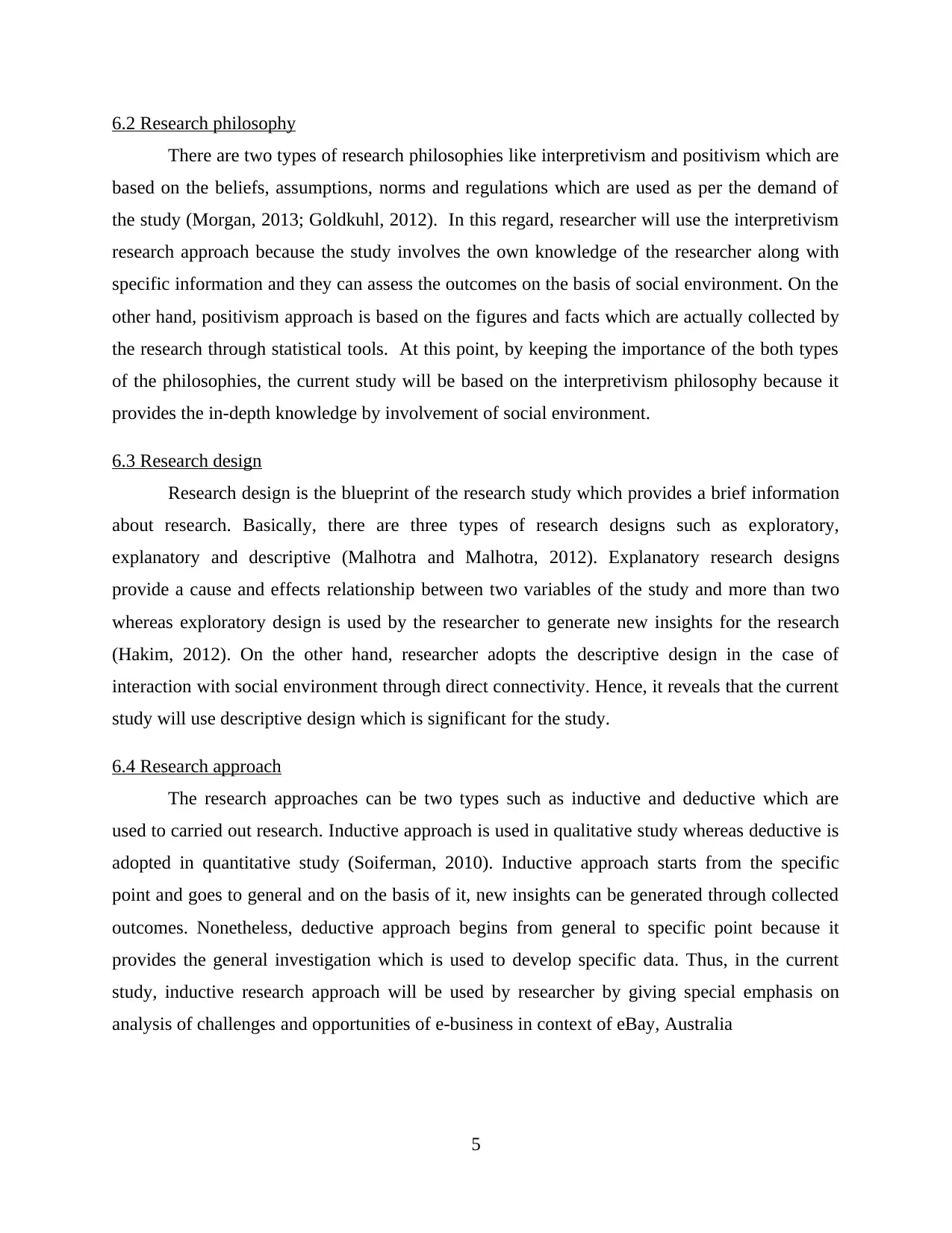
6.2 Research philosophy
There are two types of research philosophies like interpretivism and positivism which are
based on the beliefs, assumptions, norms and regulations which are used as per the demand of
the study (Morgan, 2013; Goldkuhl, 2012). In this regard, researcher will use the interpretivism
research approach because the study involves the own knowledge of the researcher along with
specific information and they can assess the outcomes on the basis of social environment. On the
other hand, positivism approach is based on the figures and facts which are actually collected by
the research through statistical tools. At this point, by keeping the importance of the both types
of the philosophies, the current study will be based on the interpretivism philosophy because it
provides the in-depth knowledge by involvement of social environment.
6.3 Research design
Research design is the blueprint of the research study which provides a brief information
about research. Basically, there are three types of research designs such as exploratory,
explanatory and descriptive (Malhotra and Malhotra, 2012). Explanatory research designs
provide a cause and effects relationship between two variables of the study and more than two
whereas exploratory design is used by the researcher to generate new insights for the research
(Hakim, 2012). On the other hand, researcher adopts the descriptive design in the case of
interaction with social environment through direct connectivity. Hence, it reveals that the current
study will use descriptive design which is significant for the study.
6.4 Research approach
The research approaches can be two types such as inductive and deductive which are
used to carried out research. Inductive approach is used in qualitative study whereas deductive is
adopted in quantitative study (Soiferman, 2010). Inductive approach starts from the specific
point and goes to general and on the basis of it, new insights can be generated through collected
outcomes. Nonetheless, deductive approach begins from general to specific point because it
provides the general investigation which is used to develop specific data. Thus, in the current
study, inductive research approach will be used by researcher by giving special emphasis on
analysis of challenges and opportunities of e-business in context of eBay, Australia
5
There are two types of research philosophies like interpretivism and positivism which are
based on the beliefs, assumptions, norms and regulations which are used as per the demand of
the study (Morgan, 2013; Goldkuhl, 2012). In this regard, researcher will use the interpretivism
research approach because the study involves the own knowledge of the researcher along with
specific information and they can assess the outcomes on the basis of social environment. On the
other hand, positivism approach is based on the figures and facts which are actually collected by
the research through statistical tools. At this point, by keeping the importance of the both types
of the philosophies, the current study will be based on the interpretivism philosophy because it
provides the in-depth knowledge by involvement of social environment.
6.3 Research design
Research design is the blueprint of the research study which provides a brief information
about research. Basically, there are three types of research designs such as exploratory,
explanatory and descriptive (Malhotra and Malhotra, 2012). Explanatory research designs
provide a cause and effects relationship between two variables of the study and more than two
whereas exploratory design is used by the researcher to generate new insights for the research
(Hakim, 2012). On the other hand, researcher adopts the descriptive design in the case of
interaction with social environment through direct connectivity. Hence, it reveals that the current
study will use descriptive design which is significant for the study.
6.4 Research approach
The research approaches can be two types such as inductive and deductive which are
used to carried out research. Inductive approach is used in qualitative study whereas deductive is
adopted in quantitative study (Soiferman, 2010). Inductive approach starts from the specific
point and goes to general and on the basis of it, new insights can be generated through collected
outcomes. Nonetheless, deductive approach begins from general to specific point because it
provides the general investigation which is used to develop specific data. Thus, in the current
study, inductive research approach will be used by researcher by giving special emphasis on
analysis of challenges and opportunities of e-business in context of eBay, Australia
5
Paraphrase This Document
Need a fresh take? Get an instant paraphrase of this document with our AI Paraphraser
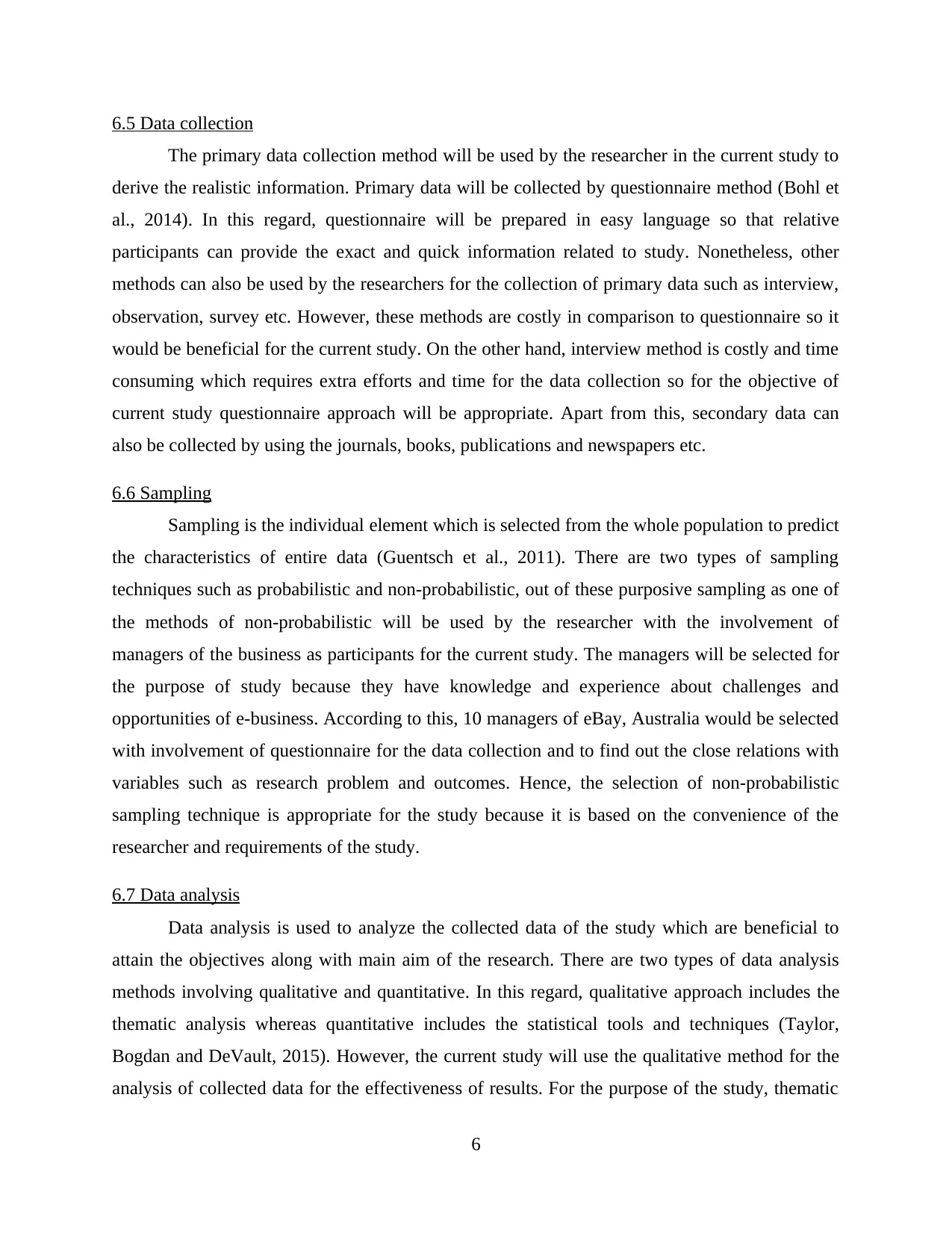
6.5 Data collection
The primary data collection method will be used by the researcher in the current study to
derive the realistic information. Primary data will be collected by questionnaire method (Bohl et
al., 2014). In this regard, questionnaire will be prepared in easy language so that relative
participants can provide the exact and quick information related to study. Nonetheless, other
methods can also be used by the researchers for the collection of primary data such as interview,
observation, survey etc. However, these methods are costly in comparison to questionnaire so it
would be beneficial for the current study. On the other hand, interview method is costly and time
consuming which requires extra efforts and time for the data collection so for the objective of
current study questionnaire approach will be appropriate. Apart from this, secondary data can
also be collected by using the journals, books, publications and newspapers etc.
6.6 Sampling
Sampling is the individual element which is selected from the whole population to predict
the characteristics of entire data (Guentsch et al., 2011). There are two types of sampling
techniques such as probabilistic and non-probabilistic, out of these purposive sampling as one of
the methods of non-probabilistic will be used by the researcher with the involvement of
managers of the business as participants for the current study. The managers will be selected for
the purpose of study because they have knowledge and experience about challenges and
opportunities of e-business. According to this, 10 managers of eBay, Australia would be selected
with involvement of questionnaire for the data collection and to find out the close relations with
variables such as research problem and outcomes. Hence, the selection of non-probabilistic
sampling technique is appropriate for the study because it is based on the convenience of the
researcher and requirements of the study.
6.7 Data analysis
Data analysis is used to analyze the collected data of the study which are beneficial to
attain the objectives along with main aim of the research. There are two types of data analysis
methods involving qualitative and quantitative. In this regard, qualitative approach includes the
thematic analysis whereas quantitative includes the statistical tools and techniques (Taylor,
Bogdan and DeVault, 2015). However, the current study will use the qualitative method for the
analysis of collected data for the effectiveness of results. For the purpose of the study, thematic
6
The primary data collection method will be used by the researcher in the current study to
derive the realistic information. Primary data will be collected by questionnaire method (Bohl et
al., 2014). In this regard, questionnaire will be prepared in easy language so that relative
participants can provide the exact and quick information related to study. Nonetheless, other
methods can also be used by the researchers for the collection of primary data such as interview,
observation, survey etc. However, these methods are costly in comparison to questionnaire so it
would be beneficial for the current study. On the other hand, interview method is costly and time
consuming which requires extra efforts and time for the data collection so for the objective of
current study questionnaire approach will be appropriate. Apart from this, secondary data can
also be collected by using the journals, books, publications and newspapers etc.
6.6 Sampling
Sampling is the individual element which is selected from the whole population to predict
the characteristics of entire data (Guentsch et al., 2011). There are two types of sampling
techniques such as probabilistic and non-probabilistic, out of these purposive sampling as one of
the methods of non-probabilistic will be used by the researcher with the involvement of
managers of the business as participants for the current study. The managers will be selected for
the purpose of study because they have knowledge and experience about challenges and
opportunities of e-business. According to this, 10 managers of eBay, Australia would be selected
with involvement of questionnaire for the data collection and to find out the close relations with
variables such as research problem and outcomes. Hence, the selection of non-probabilistic
sampling technique is appropriate for the study because it is based on the convenience of the
researcher and requirements of the study.
6.7 Data analysis
Data analysis is used to analyze the collected data of the study which are beneficial to
attain the objectives along with main aim of the research. There are two types of data analysis
methods involving qualitative and quantitative. In this regard, qualitative approach includes the
thematic analysis whereas quantitative includes the statistical tools and techniques (Taylor,
Bogdan and DeVault, 2015). However, the current study will use the qualitative method for the
analysis of collected data for the effectiveness of results. For the purpose of the study, thematic
6
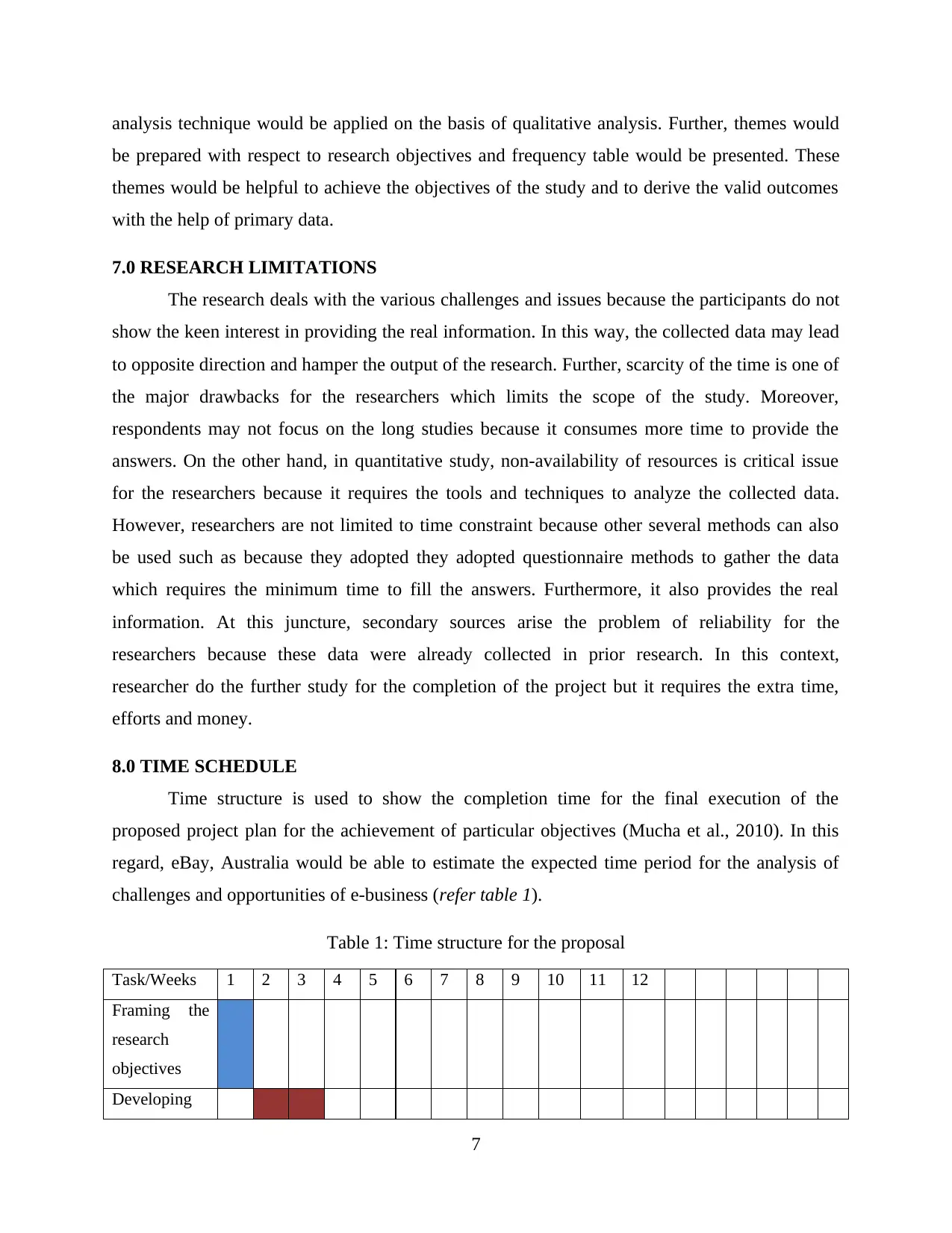
analysis technique would be applied on the basis of qualitative analysis. Further, themes would
be prepared with respect to research objectives and frequency table would be presented. These
themes would be helpful to achieve the objectives of the study and to derive the valid outcomes
with the help of primary data.
7.0 RESEARCH LIMITATIONS
The research deals with the various challenges and issues because the participants do not
show the keen interest in providing the real information. In this way, the collected data may lead
to opposite direction and hamper the output of the research. Further, scarcity of the time is one of
the major drawbacks for the researchers which limits the scope of the study. Moreover,
respondents may not focus on the long studies because it consumes more time to provide the
answers. On the other hand, in quantitative study, non-availability of resources is critical issue
for the researchers because it requires the tools and techniques to analyze the collected data.
However, researchers are not limited to time constraint because other several methods can also
be used such as because they adopted they adopted questionnaire methods to gather the data
which requires the minimum time to fill the answers. Furthermore, it also provides the real
information. At this juncture, secondary sources arise the problem of reliability for the
researchers because these data were already collected in prior research. In this context,
researcher do the further study for the completion of the project but it requires the extra time,
efforts and money.
8.0 TIME SCHEDULE
Time structure is used to show the completion time for the final execution of the
proposed project plan for the achievement of particular objectives (Mucha et al., 2010). In this
regard, eBay, Australia would be able to estimate the expected time period for the analysis of
challenges and opportunities of e-business (refer table 1).
Table 1: Time structure for the proposal
Task/Weeks 1 2 3 4 5 6 7 8 9 10 11 12
Framing the
research
objectives
Developing
7
be prepared with respect to research objectives and frequency table would be presented. These
themes would be helpful to achieve the objectives of the study and to derive the valid outcomes
with the help of primary data.
7.0 RESEARCH LIMITATIONS
The research deals with the various challenges and issues because the participants do not
show the keen interest in providing the real information. In this way, the collected data may lead
to opposite direction and hamper the output of the research. Further, scarcity of the time is one of
the major drawbacks for the researchers which limits the scope of the study. Moreover,
respondents may not focus on the long studies because it consumes more time to provide the
answers. On the other hand, in quantitative study, non-availability of resources is critical issue
for the researchers because it requires the tools and techniques to analyze the collected data.
However, researchers are not limited to time constraint because other several methods can also
be used such as because they adopted they adopted questionnaire methods to gather the data
which requires the minimum time to fill the answers. Furthermore, it also provides the real
information. At this juncture, secondary sources arise the problem of reliability for the
researchers because these data were already collected in prior research. In this context,
researcher do the further study for the completion of the project but it requires the extra time,
efforts and money.
8.0 TIME SCHEDULE
Time structure is used to show the completion time for the final execution of the
proposed project plan for the achievement of particular objectives (Mucha et al., 2010). In this
regard, eBay, Australia would be able to estimate the expected time period for the analysis of
challenges and opportunities of e-business (refer table 1).
Table 1: Time structure for the proposal
Task/Weeks 1 2 3 4 5 6 7 8 9 10 11 12
Framing the
research
objectives
Developing
7
⊘ This is a preview!⊘
Do you want full access?
Subscribe today to unlock all pages.

Trusted by 1+ million students worldwide

proposal
Preparing
introduction
Developing
research
methodology
Preparing a
plan for
collecting
data
Collecting
primary data
Collecting
secondary
data
Reviewing
the collected
data
Analyzing the
reviewed data
Framing the
conclusion
Finalization
of project
9.0 CONCLUSION
On the basis of proposal, it has been found that the research study is based on the analysis
of challenges and opportunities of e-business. It has been concluded that the if the eBay,
Australia would focus on strategies to deal with the challenges then the company would be able
to know about the available opportunities or may create the new chances for the growth of the
company. Further, it has also been summarized that for this proposal qualitative study would be
used for the analysis of data which will be collected by primary methods. Moreover, descriptive
8
Preparing
introduction
Developing
research
methodology
Preparing a
plan for
collecting
data
Collecting
primary data
Collecting
secondary
data
Reviewing
the collected
data
Analyzing the
reviewed data
Framing the
conclusion
Finalization
of project
9.0 CONCLUSION
On the basis of proposal, it has been found that the research study is based on the analysis
of challenges and opportunities of e-business. It has been concluded that the if the eBay,
Australia would focus on strategies to deal with the challenges then the company would be able
to know about the available opportunities or may create the new chances for the growth of the
company. Further, it has also been summarized that for this proposal qualitative study would be
used for the analysis of data which will be collected by primary methods. Moreover, descriptive
8
Paraphrase This Document
Need a fresh take? Get an instant paraphrase of this document with our AI Paraphraser

research design will be used by the company for the in-depth analysis of collected data. At this
juncture, inductive research approach will be applied to derive the specific outcomes. At the end,
10 managers would be selected for the analysis of data regarding challenges and opportunities of
e-business of eBay, Australia.
9
juncture, inductive research approach will be applied to derive the specific outcomes. At the end,
10 managers would be selected for the analysis of data regarding challenges and opportunities of
e-business of eBay, Australia.
9
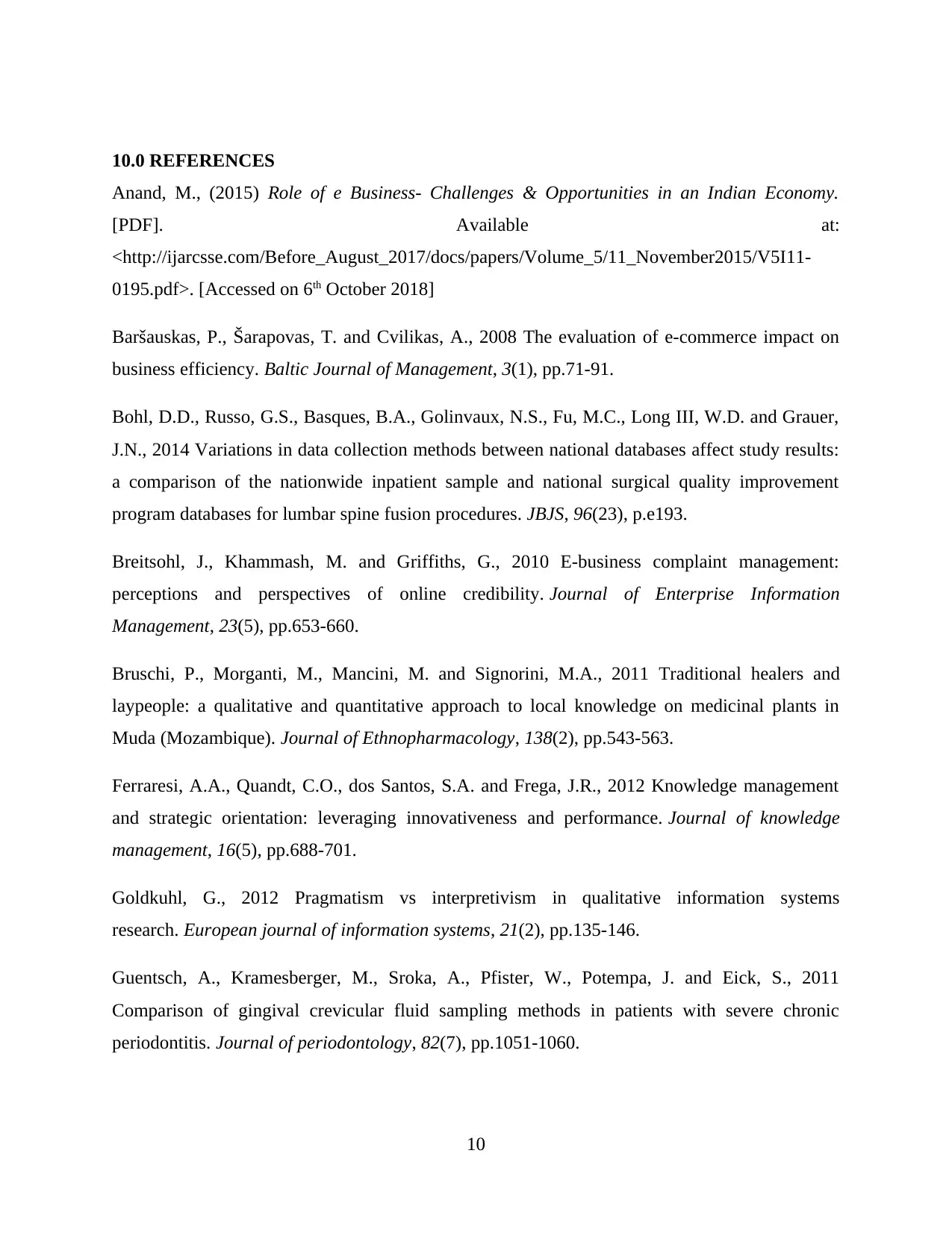
10.0 REFERENCES
Anand, M., (2015) Role of e Business- Challenges & Opportunities in an Indian Economy.
[PDF]. Available at:
<http://ijarcsse.com/Before_August_2017/docs/papers/Volume_5/11_November2015/V5I11-
0195.pdf>. [Accessed on 6th October 2018]
Baršauskas, P., Šarapovas, T. and Cvilikas, A., 2008 The evaluation of e-commerce impact on
business efficiency. Baltic Journal of Management, 3(1), pp.71-91.
Bohl, D.D., Russo, G.S., Basques, B.A., Golinvaux, N.S., Fu, M.C., Long III, W.D. and Grauer,
J.N., 2014 Variations in data collection methods between national databases affect study results:
a comparison of the nationwide inpatient sample and national surgical quality improvement
program databases for lumbar spine fusion procedures. JBJS, 96(23), p.e193.
Breitsohl, J., Khammash, M. and Griffiths, G., 2010 E-business complaint management:
perceptions and perspectives of online credibility. Journal of Enterprise Information
Management, 23(5), pp.653-660.
Bruschi, P., Morganti, M., Mancini, M. and Signorini, M.A., 2011 Traditional healers and
laypeople: a qualitative and quantitative approach to local knowledge on medicinal plants in
Muda (Mozambique). Journal of Ethnopharmacology, 138(2), pp.543-563.
Ferraresi, A.A., Quandt, C.O., dos Santos, S.A. and Frega, J.R., 2012 Knowledge management
and strategic orientation: leveraging innovativeness and performance. Journal of knowledge
management, 16(5), pp.688-701.
Goldkuhl, G., 2012 Pragmatism vs interpretivism in qualitative information systems
research. European journal of information systems, 21(2), pp.135-146.
Guentsch, A., Kramesberger, M., Sroka, A., Pfister, W., Potempa, J. and Eick, S., 2011
Comparison of gingival crevicular fluid sampling methods in patients with severe chronic
periodontitis. Journal of periodontology, 82(7), pp.1051-1060.
10
Anand, M., (2015) Role of e Business- Challenges & Opportunities in an Indian Economy.
[PDF]. Available at:
<http://ijarcsse.com/Before_August_2017/docs/papers/Volume_5/11_November2015/V5I11-
0195.pdf>. [Accessed on 6th October 2018]
Baršauskas, P., Šarapovas, T. and Cvilikas, A., 2008 The evaluation of e-commerce impact on
business efficiency. Baltic Journal of Management, 3(1), pp.71-91.
Bohl, D.D., Russo, G.S., Basques, B.A., Golinvaux, N.S., Fu, M.C., Long III, W.D. and Grauer,
J.N., 2014 Variations in data collection methods between national databases affect study results:
a comparison of the nationwide inpatient sample and national surgical quality improvement
program databases for lumbar spine fusion procedures. JBJS, 96(23), p.e193.
Breitsohl, J., Khammash, M. and Griffiths, G., 2010 E-business complaint management:
perceptions and perspectives of online credibility. Journal of Enterprise Information
Management, 23(5), pp.653-660.
Bruschi, P., Morganti, M., Mancini, M. and Signorini, M.A., 2011 Traditional healers and
laypeople: a qualitative and quantitative approach to local knowledge on medicinal plants in
Muda (Mozambique). Journal of Ethnopharmacology, 138(2), pp.543-563.
Ferraresi, A.A., Quandt, C.O., dos Santos, S.A. and Frega, J.R., 2012 Knowledge management
and strategic orientation: leveraging innovativeness and performance. Journal of knowledge
management, 16(5), pp.688-701.
Goldkuhl, G., 2012 Pragmatism vs interpretivism in qualitative information systems
research. European journal of information systems, 21(2), pp.135-146.
Guentsch, A., Kramesberger, M., Sroka, A., Pfister, W., Potempa, J. and Eick, S., 2011
Comparison of gingival crevicular fluid sampling methods in patients with severe chronic
periodontitis. Journal of periodontology, 82(7), pp.1051-1060.
10
⊘ This is a preview!⊘
Do you want full access?
Subscribe today to unlock all pages.

Trusted by 1+ million students worldwide
1 out of 14
Related Documents
Your All-in-One AI-Powered Toolkit for Academic Success.
+13062052269
info@desklib.com
Available 24*7 on WhatsApp / Email
![[object Object]](/_next/static/media/star-bottom.7253800d.svg)
Unlock your academic potential
Copyright © 2020–2026 A2Z Services. All Rights Reserved. Developed and managed by ZUCOL.





